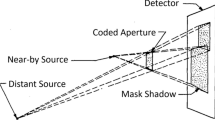Abstract
Purpose
Accurate localization of radioactive materials is critical to nuclear safety and nuclear security. A coded aperture imaging system provides a visualization solution. However, the correlation method has poor reconstruction performance for sources with low counts and for extended sources.
Methods
In this study, a Monte Carlo optimization-based MLEM algorithm (MC-MLEM) is proposed. The system matrix was obtained by accurate Monte Carlo simulation, so the physical effects such as mask penetration that affect the imaging process were taken into account in the MLEM algorithm. In the simulation process, the normalization of the system matrix was realized by controlling the source at different position of the source plane to have the same activity and emission angle.
Results
The experimental results showed that compared with the correlation method, the MC-MLEM algorithm could improve the signal-to-noise ratio and angular resolution and locate the source position quickly and accurately under low count conditions. Furthermore, the MC-MLEM algorithm could reconstruct the shape of the extended source and the expected activity ratio of cold-hot sources with large activity differences.
Conclusion
The MC-MLEM algorithm improved the imaging results and enhanced the reconstruction performance.








Similar content being viewed by others
References
M.J. Cieślak, K.A.A. Gamage, R. Glover, Coded-aperture imaging systems: past, present and future development—A review. Radiat. Meas. 92, 59–71 (2016)
K. Amgarou et al., A comprehensive experimental characterization of the iPIX gamma imager. J. Instrum. 11, P08012–P08012 (2016)
O. Gal et al., Development of a portable gamma camera with coded aperture. Nucl. Instrum. Methods Phys. Res. Sect. A Accel. Spectrom. Detect. Assoc. Equip. 563, 233–237 (2006)
A.L. Mladenov, D. Stankov, T.Z. Nonova, K. Krezhov, Radiation protection, radioactive waste management and site monitoring at the nuclear scientific experimental and educational centre irt-sofia at inrne-bas. Radiat. Prot. Dosimetry 162, 176–181 (2014)
L. Caballero et al., Gamma-ray imaging system for real-time measurements in nuclear waste characterisation. J. Instrum. 13, P03016–P03016 (2018)
E. Furuta, Semi-quantitative analysis of leaf surface contamination by radioactivity from the Fukushima Daiichi nuclear power plant accident using HPGe and imaging plate. J. Radioanal. Nucl. Chem. 297, 337–342 (2013)
C.G. Wahl et al., The Polaris-H imaging spectrometer. Nucl. Instrum. Methods Phys. Res. Sect. A Accel. Spectrom. Detect. Assoc. Equip. 784, 377–381 (2015)
R.W. Todd, J.M. Nightingale, D.B. Everett, A proposed γ camera. Nature 251, 132–134 (1974)
A. Haboub, A.A. Macdowell, S. Marchesini, D.Y. Parkinson, Coded aperture imaging for fluorescent x-rays. Rev. Sci. Instrum. 85, 063704–063704 (2014)
T. Collaboration. Lhc. Precision luminosity measurements at LHCb. J. Instrum. 9, P12005–P12005 (2014)
A. Zoglauer, M. Galloway, M. Amman, P.N. Luke, S.E. Boggs, Aerial standoff detection with the High Efficiency Multimode Imager (HEMI). In: IEEE nuclear science symposuim & medical imaging conference 566–570 (2010). doi:https://doi.org/10.1109/NSSMIC.2010.5873824
M.A. Alnafea, K. Wells, M. Guy, N.M. Spyrou, Near field corrections for coded aperture imaging in scintimammography. In: 2006 IEEE nuclear science symposium conference record. 5, 2948–2953 (2006)
M. Jeong, B. Van, B.T. Wells, L.J. Dries, M.D. Hammig, Comparison between pixelated scintillators: CsI(Tl), LaCl 3(Ce) and LYSO(Ce) when coupled to a silicon photomultipliers Array. Nucl. Instrum. Methods Phys. Res. Sect. A Accel. Spectrom. Detect. Assoc. Equip. 893, 75–83 (2018)
E.E. Fenimore, T.M. Cannon, Coded aperture imaging with uniformly redundant arrays. Appl. Opt. 17, 337–347 (1978)
L.A. Shepp, Y. Vardi, Maximum likelihood reconstruction for emission tomography. IEEE Trans. Med. Imaging 1, 113–122 (1982)
D. Lazaro, Z.E. Bitar, V. Breton, D. Hill, I. Buvat, Fully 3D Monte Carlo reconstruction in SPECT: a feasibility study. Phys. Med. Biol. 50, 3739–3754 (2005)
M. Rafecas, et al. Use of a Monte-Carlo based probability matrix for 3D iterative reconstruction of MADPET-II data. In: 2003 IEEE Nuclear Science Symposium. Conference Record (IEEE Cat. No.03CH37515). 3, 1775–1779 (2003)
S. Shokouhi, et al. Statistical 3D image reconstruction for the RatCAP PET tomograph using a physically accurate, Monte Carlo based system matrix. In: IEEE symposium conference record nuclear science 2004. 6, 3901–3905 (2004)
K. Li et al., A new virtual ring-based system matrix generator for iterative image reconstruction in high resolution small volume PET systems. Phys. Med. Biol. 60, 6949–6973 (2015)
M. Jeong, M.D. Hammig, Comparison of gamma ray localization using system matrixes obtained by either MCNP simulations or ray-driven calculations for a coded-aperture imaging system. Nucl. Instrum. Methods Phys. Res. Sect. A Accel. Spectrom. Detect. Assoc. Equip. 954, 161353 (2020)
Q. Liu et al., Image reconstruction using multi-energy system matrices with a scintillator-based gamma camera for nuclear security applications. Appl. Radiat. Isot. 163, 109217 (2020)
Acknowledgements
This work was supported by the National Natural Science Foundation of China (No. 11905229).
Author information
Authors and Affiliations
Corresponding author
Ethics declarations
Conflict of interest
On behalf of all authors, the corresponding author Long Wei states that there is no conflict of interest.
Rights and permissions
Springer Nature or its licensor (e.g. a society or other partner) holds exclusive rights to this article under a publishing agreement with the author(s) or other rightsholder(s); author self-archiving of the accepted manuscript version of this article is solely governed by the terms of such publishing agreement and applicable law.
About this article
Cite this article
Yu, Y., Sun, X., Zhang, Z. et al. Image reconstruction for the coded aperture system in nuclear safety and security using a Monte Carlo-based system matrix. Radiat Detect Technol Methods 7, 263–270 (2023). https://doi.org/10.1007/s41605-023-00381-5
Received:
Revised:
Accepted:
Published:
Issue Date:
DOI: https://doi.org/10.1007/s41605-023-00381-5




